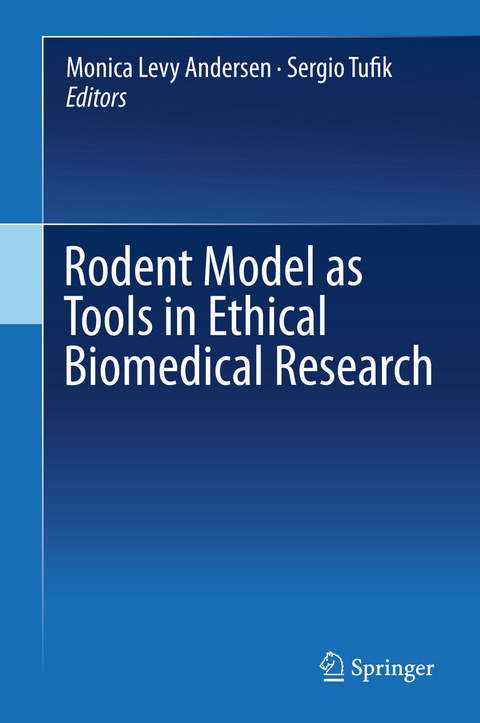
Rodent Model as Tools in Ethical Biomedical Research
Springer International Publishing (Verlag)
978-3-319-11577-1 (ISBN)
Professor Monica Levy Andersen is Master in Psychobiology and PhD in Psychobiology by Universidade Federal de São Paulo, UNIFESP, Post Doctoral Fellow at Division of Neuroscience Yerkes National Primate Research Center - Emory University. Professor of Division of Sleep at Department of Psychobiology of Universidade Federal de São Paulo (UNIFESP). Visiting Professor of Division of Neuropharmacology at Yerkes National Primate Research Center - Emory University and Division of Neurosciences of New England Primate Research Center - Harvard Medical School. Professor Sergio Tufik is Master in Physiology and PhD in Pharmacology by Universidade Federal de São Paulo, UNIFESP. Full professor of Division of Sleep at Department of Psychobiology of Universidade Federal de São Paulo, UNIFESP.
lt;p>PART 1 Ethics.- CHAPTER 1 Introduction.- CHAPTER 2 The aspects of the use of rodents in experimental research.- CHAPTER 3 The impact of the environment on laboratory animals.- CHAPTER 4 Basic concepts in alternative methods to the use of animals.- CHAPTER 5 Care and Maintenance of Laboratory Animals.- CHAPTER 6 Euthanasia.- PART 2 Use of Rats.- CHAPTER 7 The Health of Laboratory Animals.- CHAPTER 8 Rats.- CHAPTER 9 The Female Rat.- PART 3 General Procedures and Methods in Rodents Research.- CHAPTER 10 Anaesthesia in Laboratory Animals.- CHAPTER 11 Various Surgical Procedures in Rodents.- CHAPTER 12 Transgenic Animals: Principles, Methods and Applications.- CHAPTER 13 Measuring Electrocardiogram and Heart Rate in Small laboratory animals with Radi-Telemetry.- CHAPTER 14 Gene Expression Studies Using Microarrays.- CHAPTER 15 Brain Microdialysis.- PART 4 Behavioral Models in Rodents.- CHAPTER 16 Sexual Behavior in rats: An Animal Model for the Study of the Neuroendocrine System.- CHAPTER 17 Maternal Behavior.- CHAPTER 18 Behavioral Methods to Study Learning and Memory in Rats.- CHAPTER 19 Animal Tests for Anxiety.- CHAPTER 20 The Plus-Maze Discriminative Avoidance Task: An Ethical Rodent Model for Concomitant Evaluation of Learning, Memory, Anxiety, Motor Activity and their Interactions.- CHAPTER 21 Rodent Models in Psychiatric Research.- PART 5 Other uses of Rodent Models.- CHAPTER 22 Male Reproductive Toxicology.- CHAPTER 23 Sleep Patterns in Rats.- CHAPTER 24 Narcolepsy-Cataplexy in the Rats.- CHAPTER 25 Hypoxia: Introduction of Mechanisms and Consequences.- CHAPTER 26 Assessment of Motor Function in Rodents: Behavioral Models Sharing Simplicity and Multifaceted Applicability Part 1: The Open-Field Test*.- CHAPTER 27 Assessment of Motor Function in Rodents: Behavioral Models Sharing Simplicity and Multifaceted Applicability Part 2: The Catalepsy Test.- CHAPTER 28 Assessment of Motor Function in Rodents: Behavioral Models Sharing Simplicity and Multifaceted Applicability Part 3: Orafacial Dyskinesia.- CHAPTER 29 Experimental Diet Models in the Investigation of Obesity.
| Erscheint lt. Verlag | 4.12.2015 |
|---|---|
| Zusatzinfo | XVII, 516 p. 194 illus., 137 illus. in color. |
| Verlagsort | Cham |
| Sprache | englisch |
| Maße | 155 x 235 mm |
| Themenwelt | Geisteswissenschaften ► Psychologie ► Verhaltenstherapie |
| Medizin / Pharmazie ► Studium | |
| Naturwissenschaften ► Biologie ► Humanbiologie | |
| Naturwissenschaften ► Biologie ► Zoologie | |
| Schlagworte | Behaviour • biomedical research • Biomedical Sciences • Neurosciences • Rodents |
| ISBN-10 | 3-319-11577-4 / 3319115774 |
| ISBN-13 | 978-3-319-11577-1 / 9783319115771 |
| Zustand | Neuware |
| Haben Sie eine Frage zum Produkt? |
aus dem Bereich


